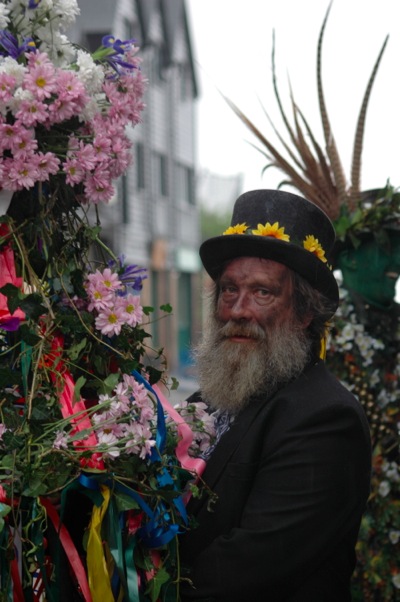hot cross buns
“Have your cake and eat it”
a trip through regional British cakes
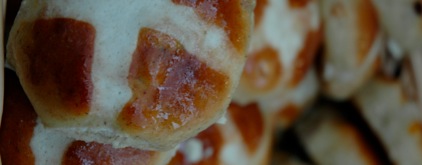
Hot cross buns!
Hot cross buns!
One a penny, two a penny,
Hot cross buns!
If ye have no daughters,
Give them to your sons.
One a penny, two a penny,
Hot cross buns.
The cry of the street vendors as they carried their wares through the streets, a tray of buns perched on their heads.
Easter time has come around again but sadly the street vendors are no longer.
Hot Cross buns have long been a symbol of Good Friday. Today they are sold in bakery shops and supermarket bakeries throughout the Easter season. Each bun has an icing cross on top to signify the crucifixion.
Although this tradition has been going on for centuries the real roots go much further back.
The British history has along association with paganism the cross on the top of the bun would have originally have represented the four quarters of the moon.
Early Christians would have reinterpreted the meaning to signify the crucifixion.
In 1361, a monk named Father Thomas Rockcliffe began a tradition of giving Hot Cross Buns to the poor of St Albans on Good Friday.
In the years that followed, many customs, traditions, superstitions, and claims of rejuvenation, protection from evil and were associated with the buns. In the 16th century, the Roman Church was banned in England, but the popularity of Hot Cross buns continued. Queen Elizabeth I passed a law banning the consumption of Hot Cross Buns except during festivals such as Easter, Christmas and funerals.
Eccles cakes
1793 was a good year for cake making in the town of Eccles.
James Birch began to sell his small flat raisin filled cakes
Starting a culinary legend.
Although traditionally made in the town from where they get their name, Eccles cakes are now known throughout the world. As early as 1818 they were said to be sold "at all the markets and fairs around and were even exported to America and the West Indies".
The word 'Eccles' means church 'Eccles Wakes' took place at the church in Eccles and afterwards there was a fair at which food and drink were sold, including of course, Eccles cakes.
In 1650, when the Oliver Cromwell gained power, they banned the Eccles Wakes and subsequently the Eccles cakes, which they considered to have pagan significance due to their juicy and exotic richness.
St John in London’s Smithfield has always served Eccles cakes with Lancashire cheese a great combination.
Lardy cake
More of a bread than a cake this came about when fruit and spices became available to the British in the 17th century the recipe was developed using a basic bread dough with the fat content being lard rendered from pigs with the addition of sugar spices and dried soft fruits. It was called lardy cake in the West Country, lardy johns in Sussex, dough cake in Buckinghamshire and in Suffolk there was something similar called Fourses Cake.
The cake that isn’t
The Kendal mint cake is not really a cake at all a sweet containing a high amount of sugar and glucose, something that has helped its legend.
Sir Edmund Hillary took the sweet to the top of mount Everest as a good source of energy, available in a small size.
A mistake that went well, according to myth a confectioner was trying to make glacier mints, when his attention wandered, only to discover that the contents of his pan had turned cloudy and grainy, he kept it anyway and upon trying found it to be delicious.
The recipe is credited to Joseph Wiper, who produced the cakes in his shop in the 1800s. His great nephew, Robert Wiper, supplied Kendal Mint Cakes as energy boosters to the 1914-17 Arctic Expedition under the command of Shackleton.
Here in the UK are many regional cakes but many do not travel out of the borders of their County, so the only way to find the new and the old is to travel slowly and enjoy eating cake!
Pagans
The pagans seem to have had lots of fun at their festivals some of which still live on even now, but adaptations have taken place over the centuries.
The puritans will have made sure that all pagan Rites were stopped or integrated into the church to appease the people and bring them to church. One such is jack of the green celebrated in Hastings
in east Sussex.
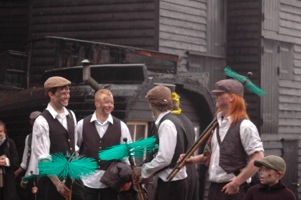
This is held on the first of May or Beltrane (day of fire) .
Its origins seem to have started with the Saxons a celebration of the end of winter and the start of the sun.
Peasants would take part in games and feasting the night before, ending with carrying flaming torches into the hills then roll burning wooden wheels into the fields.
These events were stopped by the church but did continue in secret by the participants dressing up and wearing masks, this practice continued up until the late 1700s.
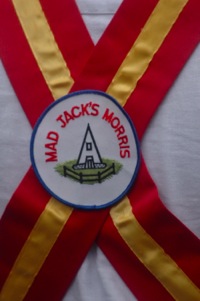
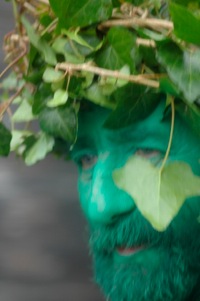
May day continued it stayed an irreverent, raucous occasion. Villages would elect a "Queen of the May" from their eligible young women to rule the crops until Harvest. They would also build a "May Pole", a phallic symbol around which young single men and women would dance, holding on to the ribbons until they became
In the 16th and 17th centuries people developed this practice by making garlands of flowers and leaves for the May Day celebration.
Over the years, these garlands became more and more elaborate with people trying to outdo each other.
By the late 18th century, the celebrations had become so competitive that London Milkmaids carried silver-studded garlands on their heads while the Chimney Sweeps’ garland was so big it covered an entire man!
The Chimney Sweeps’ garland eventually became a costume character in its own right known as "Jack-in-the-Green".
In Hastings there were at least two groups who paraded a Jack-in-the-Green until about 1889.
Shortly after this the celebrations were stopped because of a Parliamentary Act preventing boys from working as Chimney Sweeps (the procession’s main performers) and the Victorian’s dislike of drunken and promiscuous behavior.
The festival was restarted In 1983, by the mad jacks Morris dancers The ‘Jack-in-the-Green Festival of Morris Dancing’ has turned May Day into one of the most important dates on Hastings events calendar.
In an extraordinary splash of vivid greens and movement, a stream of dancers, drummers and performers make their way through the narrow streets of the Old Town, across the seafront and up to the hilltop ruins of Hastings Castle.
Here the Jack is symbolically slain and the spirit of the summer released in a ceremony that’s enjoyed by thousands.

Barcelona
September is a great time to travel to Barcelona warmer than the UK.
Packed with culture and art there is also the fiesta de Merce which runs from the 24 till the 30 September crowd pleasing events such as firework parades with giants in local dress, dragons and loud music.
Running concurrently is a music festival featuring some of the world’s best artists taking place at various venues and squares around Barcelona.
I was there for different reasons, to sample the current hot restaurants and Classic ones too.
Barcelona is so diverse from medieval centre to Olympic village.
The markets are fantastic such great produce always inspiring and segrada famillia the unfinished Gaudi masterpiece is just jaw-dropping.
I stayed in the lower Raval well known for its drug related problems and seedy atmosphere, the council seems to be taking a brave step by bulldozing the worst areas and building public spaces it appears to work, it still can be a little edgy but I rather like that.

I ate a three different Michelin starred restaurants which were all good, two in particular came out on top Lasarte which started with the signature dish of smoked eel foie gras and caramelized apple terrine and finished with a chocolate filled with praline and salt I can not even begin to explain how good that was and there was only one.
The cram hotel a contemporary hotel in Exaimple contains Can Gaig a Michelin starred restaurant recently relocated from its original building as that was beyond repair. The Gaig family has been chefs for 130 years and Carles is the current incarnation.
Intimate describes well the surroundings of the restaurant deep
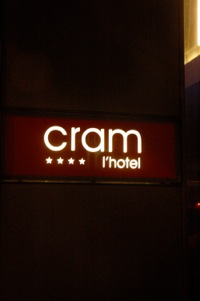
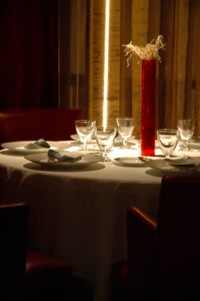
hues of red and subtly lit.
The tasting menu is recommended as it gives a wide selection of the kitchens skills.
Unfortunately one course marred the whole meal a belly of tuna perfectly cooked but salty beyond sense after a mouthful all that could be tasted was salt, it ruined the wine and it took two courses before I regained use my taste buds .
The meal rallied towards the end and redeemed itself.

At Abac I ate as one of the 8 courses smoked anchovy with garlic ice cream it almost brought tears to my eyes it was so good it had just been warmed through in the smoker so it was barely cooked just meltingly delicious, paired with a tiny Quenelle of roasted garlic ice cream and a thin wafer of toast just genius.
With Chef Xavier Peliccio at the helm, this restaurant continues to produce involving well thought out beautifully presented dishes, with a nod to old culinary traditions and recipes.
I was overwhelmed by the finesse creativity and flavours presented in his tasting menu I was lucky enough to receive an extra course of roast best end of suckling pig just perfect the cracking thin and crispy like paper.
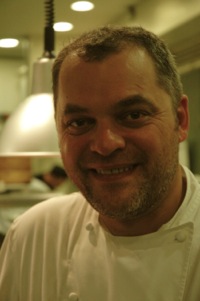
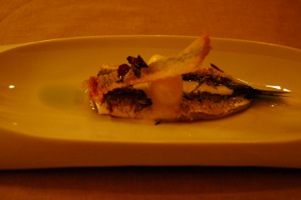
I spoke with Xavier and visited His kitchens and was very pleased to see real stoves with no induction cooking.
I am a great believer in fine cuisine should be produced with heat, passion and hard work there was plenty of that going on in this kitchen.
Lasarte is an outpost of the chef Martín Berasategui The latest star in the firmament of Spanish haute cuisine housed inside the hotel condes a step away from the Pasaig de Gracia a small elongated room greets you along with charming bilingual staff styled in grey nero jackets.
There was great expectancy in regard to the eel and foie terrine I was certainly not disappointed, the smoky oiliness of the eel worked in complete harmony along with the tart freshness of caramelized apple .
Every bite was sad as I became ever closer to finishing the dish.
Restaurants at this level seem to get caught in a trap of over complication style over reasoned thought, the wine list here is a prime example .
A cork box was presented when opened it contained four more cork covered folders each containing a wine list, this was supplemented with a textural swatch evoking the mood of the wines contained within yet all wines were lacking in the needed information grape variety or even a tasting note perhaps!
The meal was peppered with culinary highlights the Ravioli of squid ink translucent pastry holding warm ink and seasoning stock eaten with shredded raw squid and a tumble of rice noodle all popped into your mouth at once to allow the ravioli to burst inside and mingle with the other ingredients was excellent.
A defining moment was with the coffee an inconspicuous chocolate contained a very fine praline and rock salt, which provided a shock to the palate there was a reevaluation of all thing chocolate happening here.
Presentation of the food, namely the finishing of the dishes erred towards twee most courses came with a jus or sauce which was added at the table which for me began to become a little tiring after several courses over complication rears its head again.
Lasarte is worth a trip if you are in Barcelona somewhat easier to reach than the parent restaurant, which is about 15 miles outside of San Sebastian, he also oversees the restaurant at the Guggenheim in Bilbao .
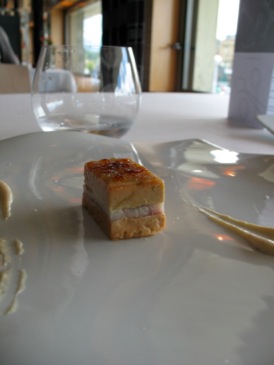
I challenge you to get bored with the food in Barcelona the market called la Boqueria is just awesome such wonderful fresh local products on display and good bars to eat at ,being close to the products makes all the difference octopus for breakfast on morning one pulpo galeggio boiled and drizzled with olive oil and paprika washed down with a glass of chilled cava
next day razor clams ,and the next tripe! Probably the best I have ever eaten.
For the traditionalists among us casa Leopoldo reigns supreme ,Barcelona is still a bullfighting city although the main bullring is being redeveloped, this restaurant is run by a family with a long bullfighting connection ,so of course you can eat oxtail here and being Barcelona there is good fish on offer too.
As my last meal before my return it could not be faulted.
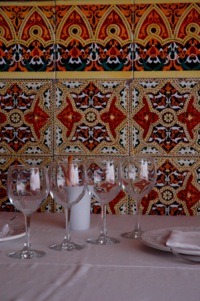
All your shopping needs can be met here in Barcelona also lots of history and culture great wine. But the down side millions of tourists with that come s the pickpockets so one has to be on their guard.
Nonetheless as for dining experiences and they were many a weekend away here has a lot to recommend it, what are you waiting for?
Information follows
Restaurant Lasarte
In the hotel condes
Passeig de Gràcia, 73-75 · 08008 Barcelona Tel. (+34) 93 445 00 00 · Fax: (+34) 93 445 32 32 e-mail: info@condesdebarcelona.com
Can Gaig
C/ ARAGÓ 214 (Aribau Corner)
Telf: 934 291 017
Fax: 934 297 002
info@restaurantgaig.com
Abac
Tues-Sat 1:30-3:30pm; Mon-Sat 8:30-10:30pm
Address
Carrer del Rec 79-89
LocationLa Ribera, Ciutat Vella
Transportation
Metro: Jaume I or Barceloneta
Phone
93-319-66-00
Casa Leopoldo Calle Rafael, 24 Tel 0034 93 441 69 42

